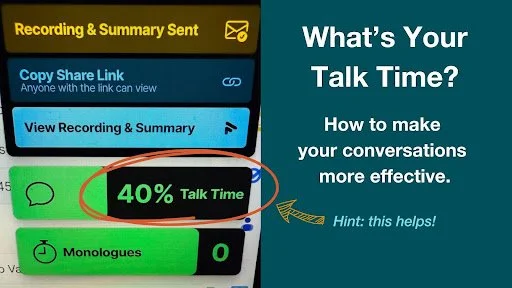How to Monitor Your Talk Time and Become a More Effective Communicator
“Most people do not listen with the intent to understand, they listen with the intent to reply.”
Stephen R. Covey
If you'd like to listen to this instead of reading it, click here
What’s the balance between talking and not talking in your conversations?
I've been trialing Fathom, an online note-taking tool that records and summarises my coaching and planning conversations. It’s brilliant. (Note - I have no affiliate status)
One of its cool features is called Talk Time. It lets me know - both during and after the conversation - what percentage of the time I’ve been talking vs. not talking.
Why does this matter?
Have you ever felt like you’ve just been talked at? When you feel like you’re on the other side of a monologue, unable to get into a two-way conversation? And as a result, you’ve left feeling unheard and undervalued?
Or perhaps you’ve been trying to get your point across but they just don’t seem to get it? Why aren’t they listening to what you’re saying?
Research by Guy Itzchakov and Avi Kluger indicates that when the person we’re talking with perceives us to be in ‘receive’ mode more than ‘transmit’ mode, they’re more likely to relax, be open to sharing more, be more open to other points of view, and be more co-operative.
All good reasons to stop talking and start listening.
In my Conversations That Matter workshop, I share Juanita Brown’s idea that conversation is a core business process. Nothing worthwhile happens without quality conversations. That includes conversations with yourself.
My rule of thumb is that I talk less than half the time. And when I am talking, I want a healthy split between asking questions and sharing my perspective.
So in the example above, I think I did pretty well! And no monologues! (In Fathom, a monologue is when you’ve been talking for 90 seconds or more in one go).
You don’t need Fathom to help your talk time. The trick is to monitor yourself. Here’s how you can do that:
Three Actionable Ways to Monitor Your Talk Time
The Breath Check Method
After making a point or sharing a thought, take a deliberate breath. During the pause, ask yourself: "Have I given the other person enough space to respond?" This simple breathing technique creates natural breaks in your speech and gives you a moment to check whether you're dominating the conversation.The Three-Sentence Rule
Challenge yourself to limit your initial responses to three sentences or fewer. If you need to elaborate, wait for the other person to ask a follow-up question. This naturally creates a rhythm of back-and-forth exchange and prevents extended monologues. When you feel the urge to add "just one more thing," recognise it as a sign to pause and invite input instead.The Phone Timer Technique
For important conversations, set your phone timer to vibrate at 90-second intervals (Fathom's "monologue" threshold). Place it in your pocket where only you can feel it. When it vibrates, gracefully wrap up your current thought and ask an open-ended question. With practice, you'll develop an internal clock that helps you maintain balanced conversations even without the timer.
Your most powerful communication tool isn't your voice. It's the silence you create that invites others to share theirs.
For more like this, check out:

